When it comes to Fashion, hope is a dream sown thread by thread, feather by feather, sequin by sequin. When it comes to Fashion, hope is a dream reflected in the colors, in the details, in the volumes. When it comes to Fashion, hope is a dream that lets us dream.
When it comes to Fashion, hope is a dream sown thread by thread, feather by feather, sequin by sequin. When it comes to Fashion, hope is a dream reflected in the colors, in the details, in the volumes. When it comes to Fashion, hope is a dream that lets us dream.
Future faith
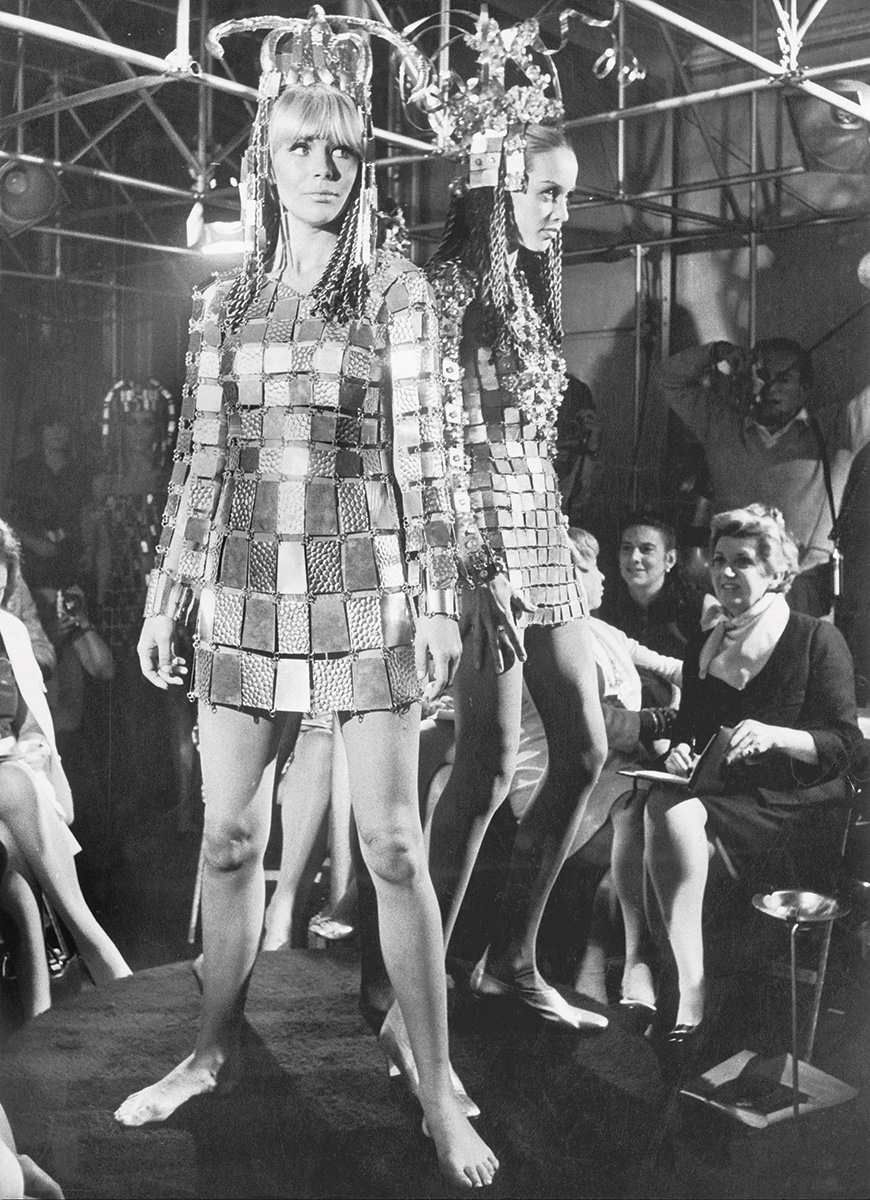
Two models wear the Armored Dress by Paco Rabanne, made from metal plates, 1968 ©Getty Images
Two models wear the Armored Dress by Paco Rabanne, made from metal plates, 1968 ©Getty Images
The definition tells us that hope is a disposition of spirit that induces one to wish hat something will happen or succeed. In other words, hope is about the future, and the future has always been (at least in the Fashion industry) about Paco Rabanne. From the use of unconventional materials such as plastic and metal to the equally innovative creations, his avant-garde designs helped launch Fashion into a new era of enthusiasm, and women into a new era of independent femininity. “My dresses are successful because they are shocking. It’s impossible for a woman to wear one and not be noticed,” the designer once said. “I thought a woman working all day in flat-heeled shoes and sensible suits needed to recapture her mystery and femininity in the evening. It was up to me to supply her with a sort of second skin – rustling, iridescent, phosphorescent, soft yet sharp, supple yet rigid, transparent yet opaque.” The designer’s dream is still very much alive today, coming to life every time a piece of metal mesh appears on the runway – and in the words of Julien Dossena, the brand’s creative director, “when I think of Paco Rabanne, I don’t think retro – I think revolution, rebellion and renaissance”.
First contact
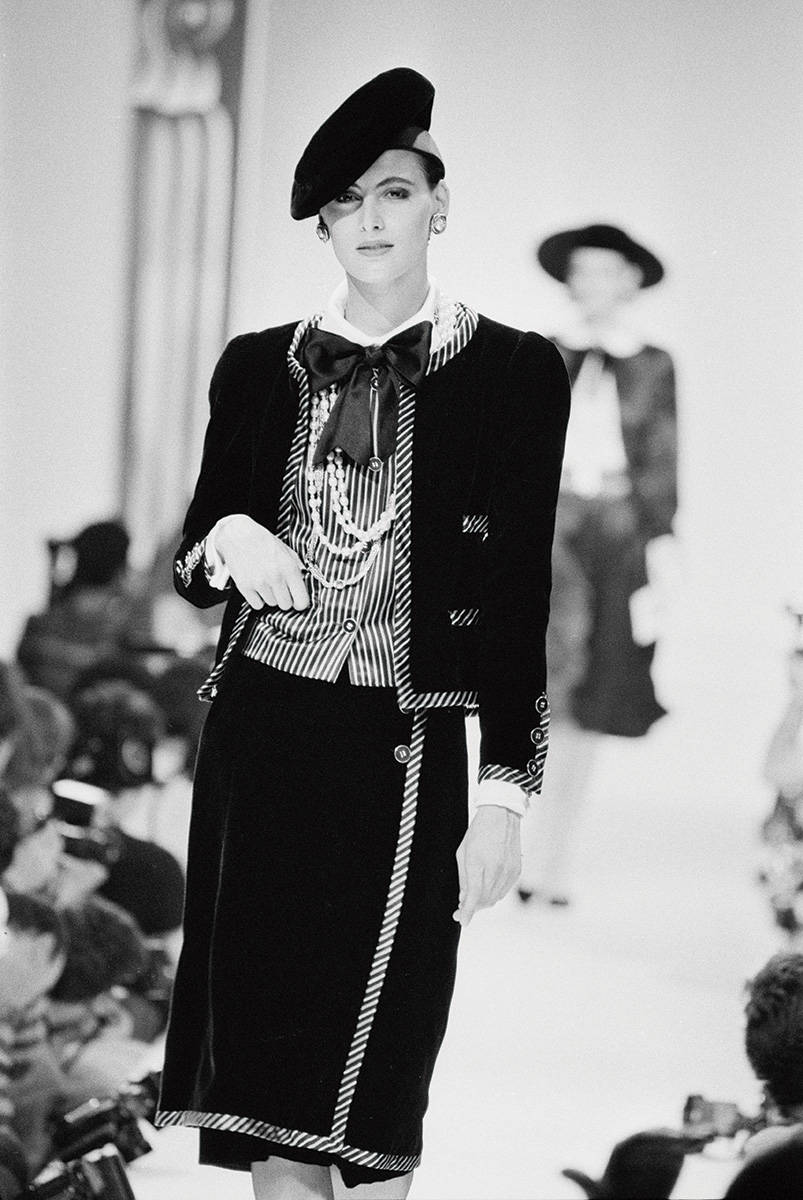
Ines de la Fressange at the Chanel Haute Couture Fall/Winter 1983 show ©Getty Images
Ines de la Fressange at the Chanel Haute Couture Fall/Winter 1983 show ©Getty Images
Is it the image we think of when we think of haute couture? Probably not. Is it the image we think of when we think of a so-called dream dress? Probably not. Is it the image one should include on a list of moments when Fashion was a dream come true, a dream that fills us up with hope in a better-off tomorrow? Without a doubt. After all, this image of Ines de la Fressange documents what was Karl Lagerfeld’s first ever Chanel collection – and everything that Karl Lagerfeld did since the first thread at the French House was, in a lack of less cliché words, a true dream. From the creations that shaped a new era for the House, transforming the Chanel name into a cult word, modern and tempting, to the megalomaniac sets of his shows (sorry, of his happenings), Lagerfeld was the one who put the F in Fashion. The one who gave it momentum, joy, meaning. The one who made it a spectacle worth watching from the front row, with the biggest attention to detail. And all of that started right there, at that Haute Couture Fall/Winter 1983 show.
When Spring comes
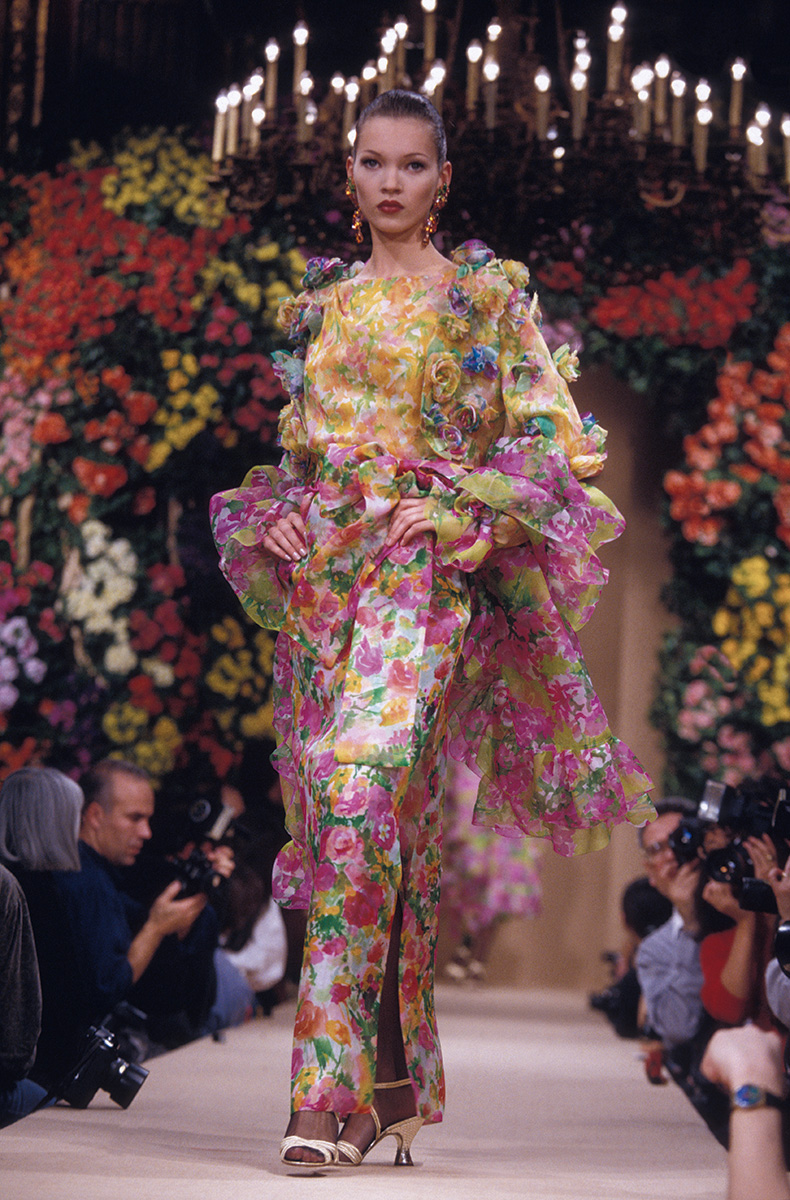
Kate Moss at the Yves Saint Laurent Spring/Summer 1993 Couture show ©Getty Images
Kate Moss at the Yves Saint Laurent Spring/Summer 1993 Couture show ©Getty Images
There’s no denying that flowers are a fashion staple (groundbreaking or not, they are a staple). Interpreted and reinterpreted in a number of ways, shapes and forms, the floral print that we associate with a sort of beauty, femininity and color is, at the same time, dystopia at Richard Quinn, kitsch at Moschino (case in point, that one time when Gigi Hadid modeled as a literal flower bouquet), femininity in Raf Simon’s Dior, and Kate Moss at the Spring/Summer 1993 Yves Saint Laurent couture collection. Why do we say that flowers are synonymous with Yves Saint Laurent? Because the moment when Kate Moss stepped on the runway with a larger than life floral dress is one of the most immaculate and unforgettable appearances of the print on the catwalk. As Julia Hobbs put it, this Yves Saint Laurent interpretation is nothing short of intoxicating. In a good way, of course.
A star is born
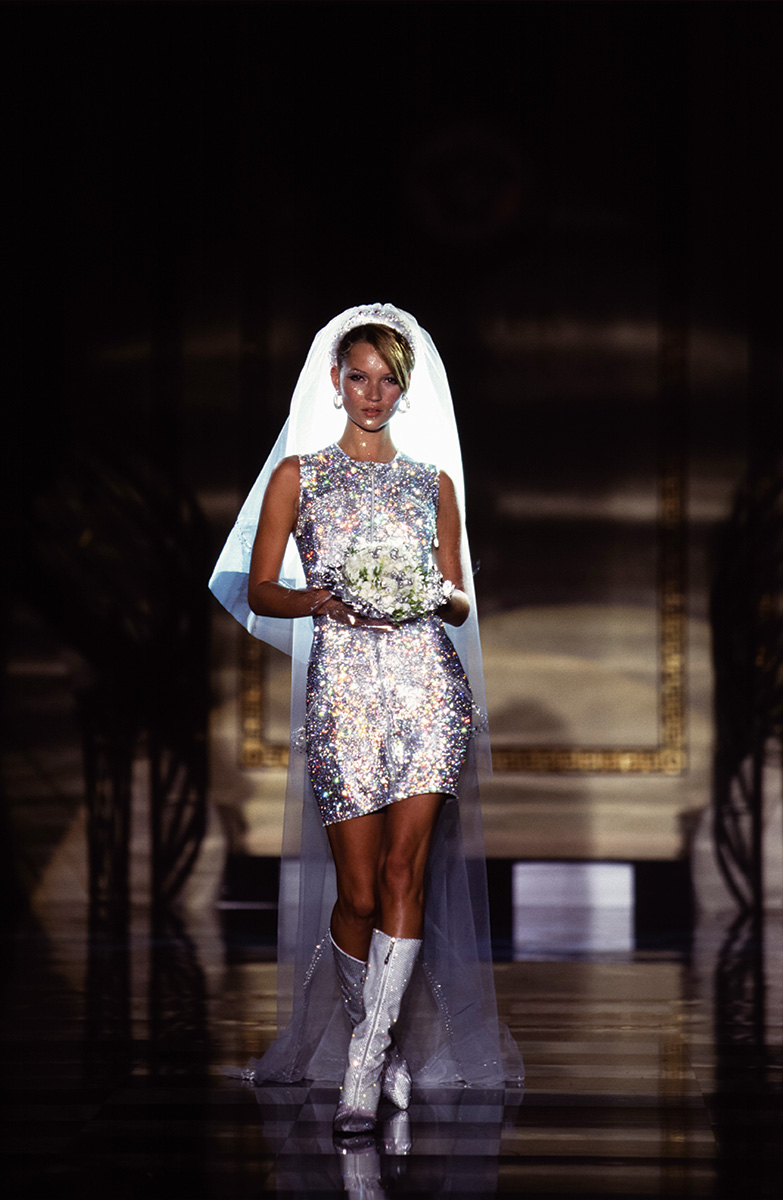
Kate Moss at the Atelier Versace Fall/Winter 1995 show ©Getty Images
Kate Moss at the Atelier Versace Fall/Winter 1995 show ©Getty Images
There is a line that separates the 90’s Haute Couture shows from the Atelier Versace 90’s Haute Couture, and that line is Gianni Versace. The high voltage that one could feel through his creations was the same high voltage that one could feel on the runway, the place where that Versace experience – loud, extravagant and sort of epic – would happen in all its plenitude and magnitude. One of the most remarkable examples of that feeling was the Fall/Winter 1995 Atelier Versace show, an affair between Gianni’s supermodel muses (Carla Bruni, Shalom Harlow, Naomi Campbell, Helena Christensen, Kristen McMenamy, you name them, they were there) and the ultra-sparkling looks created by him, with the most notorious of them all being the one worn by Kate Moss to play the role of the bride and close the show. The moment was nothing short of a shooting star crossing the sky. In the end, Gianni’s dreams may not have been painted in pink and innocence, but they were certainly glistering – and if those are not the dreams that one wants to have, then we don’t know what they are.
Out of this world

Thierry Mugler Haute Couture Spring/Summer 1997 ©Getty Images
Thierry Mugler Haute Couture Spring/Summer 1997 ©Getty Images
It’s almost impossible to talk about what a dream looks like in the Fashion industry without mentioning the one of a kind imaginary of Thierry Mugler. With him, design was an exercise of beauty with no boundaries, and hope was placed in an emancipated, irreverent, extravagant and “out of this world” woman. From the celestial figures and the women turned mermaids (the aquatic world was a fertile source of inspiration for Thierry Mugler) that came down to Earth and appeared on the coast of his 80’s shows, to the experimenting that defined the next decade, with looks transformed into automobilist creations and a first incursion in the couture world that injected a modern and fierce spirit to Haute Couture, Mugler’s universe is a universe of fantasy – a universe where hybrid creatures and robotic figures coexisted with the most sensual and powerful women. In other words, Mugler’s universe is an amazing dream – one of those dreams that we want to relive time and time again.
A Galliano kind of magic

Christian Dior Haute Couture Spring/Summer 1998 ©Getty Images
Christian Dior Haute Couture Spring/Summer 1998 ©Getty Images
It’s considered one of the most extraordinary shows of all time, and the honor is not given by mere chance. Let’s break it down: the set was the majestic Opéra Garnier, in Paris; the inspiration was Marchesa Casati, the extravagant and eccentric Italian heiress that became famous in 20th century Europe for her decadent style; the cast included models such as Nadja Auermann, Eva Herzigova, Erin O’Connor and Carolyn Murphy; and the sculptural and sumptuous looks and silhouettes, with cinched waists and Art Nouveau prints, were pure poetry in motion. All in all, it was exuberant, theatrical, dramatic, transcendent. All in all, it was John Galliano for Dior. “When you search for ‘fashion show’ in the dictionary, this is the show that should be there,” Tim Blanks said about the Christian Dior Haute Couture Spring/Summer 1998 collection. “I have stated on the record that this is my favorite show of all times. The way everything connected, from the staging to the clothes to the setting, it was like every drug experience that every person has had in 10 minutes. And then that times 100.”
Monumental McQueen
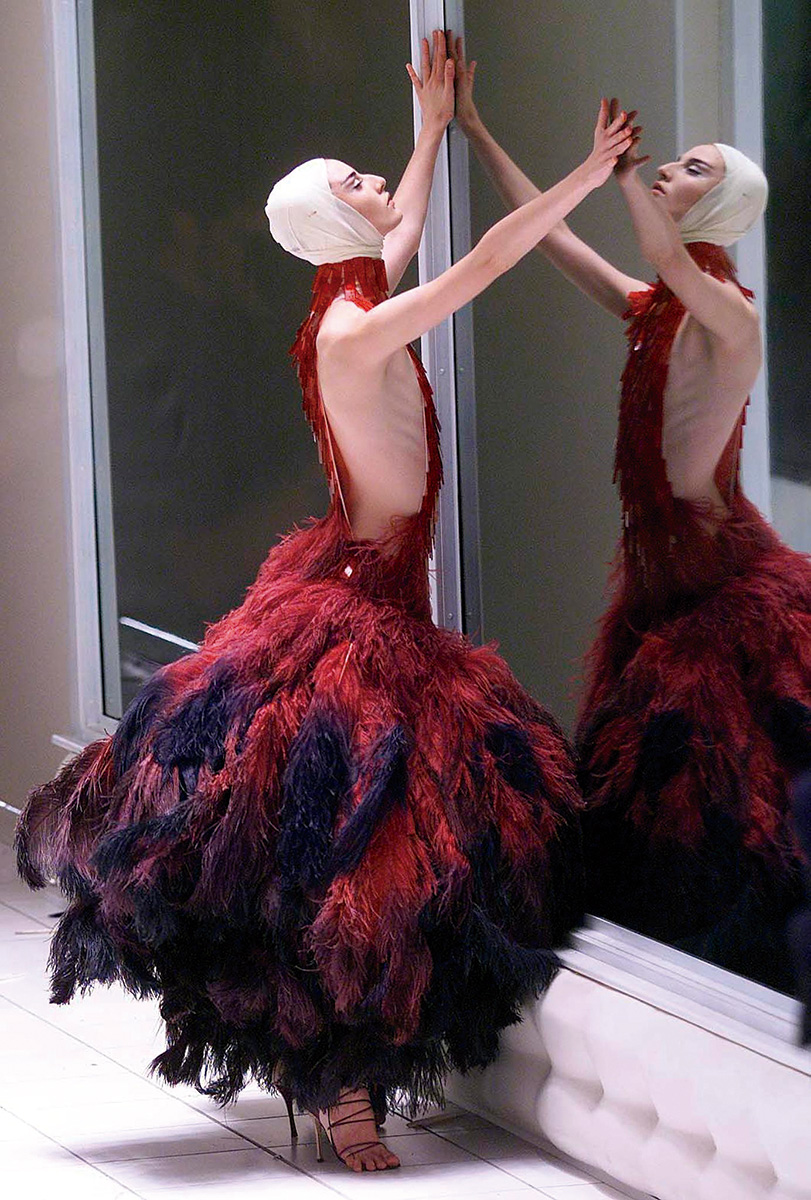
Erin O’Connor, Alexander McQueen Spring/Summer 2001 ©Getty Images
Erin O’Connor, Alexander McQueen Spring/Summer 2001 ©Getty Images
Fashion has the power of making us travel to other worlds, other realities and other times, an nobody understood that power quite like Alexander McQueen. Through his visionary genius, a look was always more than a look: it was a story, an enigma, a moment for reflection. Through his visionary genius, a show was always more than a show: it was an experience, a mystical event, an almost transcending moment. And even though his subjects were often times controversial and dim, there was always a dreamy quality (a complex, but non the less beautiful dream) in everything that Alexander McQueen did. As Aria Darcella wrote in a CR Fashion Book piece, “McQueen’s legacy as a designer is propelled by his provocative work. But unlike other provocateurs (Jean-Paul Gaultier, who rebelled with a wink, Martin Margiela, who refused to engage, and Vivienne Westwood, a literal punk), McQueen challenged audiences by exploring concepts in a painterly way, taking on dark subjects through lavish design and beauty. You don’t want to read about the thought behind his work (although the stories are often fascinating). You just want to look at it.”
Say yes to the dress
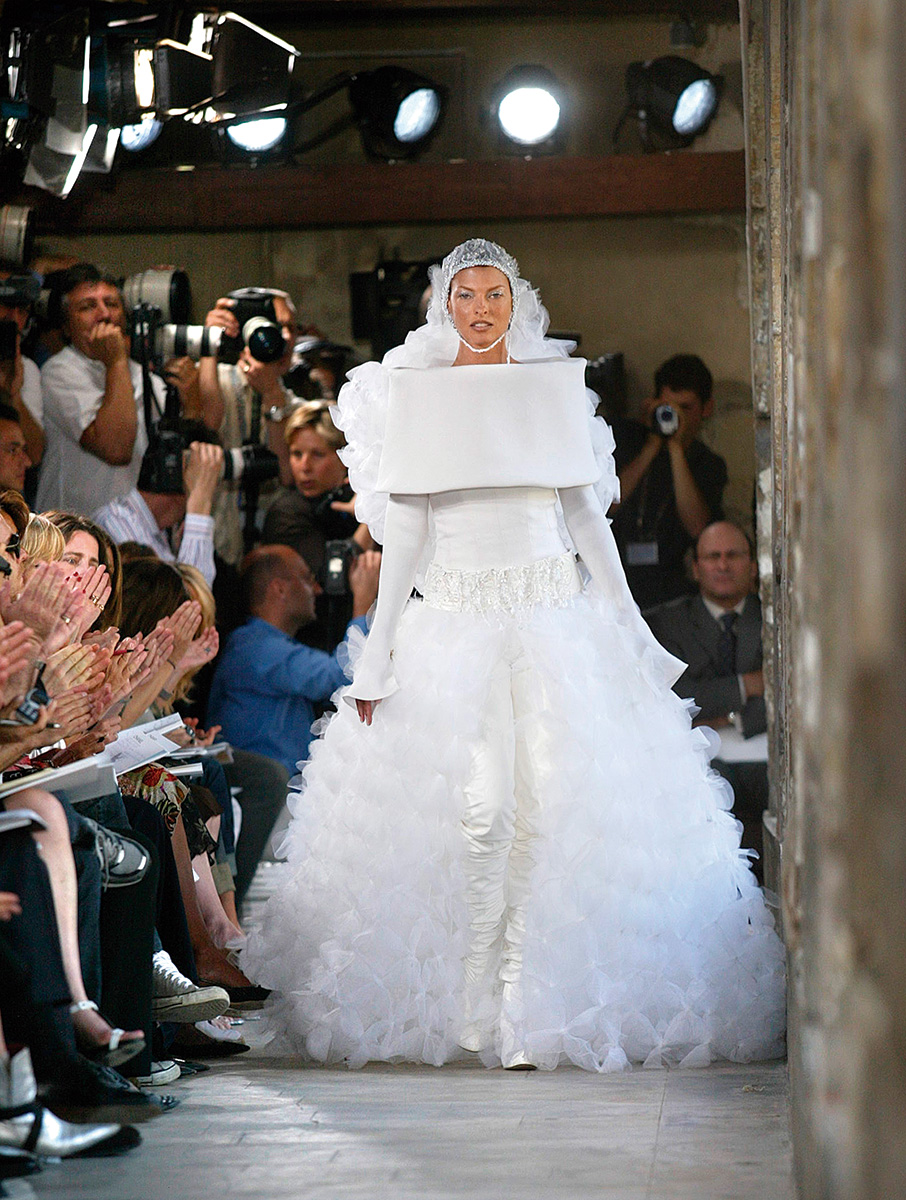
Linda Evangelista at the Chanel Haute Couture Fall/Winter 2003 show ©Getty Images
Linda Evangelista at the Chanel Haute Couture Fall/Winter 2003 show ©Getty Images
Ask anyone what the highlight (better, one of the highlights) of a Chanel Haute Couture show is, and it’s possible that the answer is “the bride”, the one who closes the show and makes anyone (even those who don’t believe in the institution of marriage) dream about the so-called big day. “Over the years he [Karl Lagerfeld] has used the bride to make statements about gay marriage, gender identity, austerity, showmanship, and above all else, pure, unadulterated beauty,” one could read in a Vogue Runway article about the majestic brides of Lagerfeld during his stay at the French House. “There have been meter-long trains, sharp pantsuits, cascading lace appliqués, and more than a few mod-ish minidresses that upended the tradition of bridalwear. And then, of course, there was the bridal maillot Vittoria Ceretti wore at his [Karl Lagerfeld’s] final haute couture show.” From Ines de la Fressange in the 80’s to the supers in the 90’s and today’s muses, such as Kendall Jenner and Lily-Rose Depp, there has been a number of models who have said yes to the dress, creating a series of unforgettable moments for the House – but none was as dreamy as the one worn by Linda Evangelista at the Haute Couture Fall/Winter 2003.
Butterfly effect

Christian Dior Haute Couture Spring/Summer 2007 ©Getty Images
Christian Dior Haute Couture Spring/Summer 2007 ©Getty Images
As the Internet will tell you, the butterfly effect is a situation in which an action or change that at first glance does not seem important ends up having a massive effect, especially in another place or around the world; as Ian Malcolm explained in the 1993 movie Jurassic Park, a butterfly flaps its wings in Beijing and the weather is New York is different. All of this is a little bit like what happened when John Galliano presented his Haute Couture Spring/Summer 2007 collection for Dior – the butterfly flapped its wings in Paris and the world of Couture (and Fashion) changed forever. Inspired by the opera Madama Butterfly and the romance between Cio-Cio-San and Pinkerton, Galliano did what he does best: a whimsical and extravagant collection, rich in colors, details, pleats, silks and satins. Essentially, Galliano did what he does best: he gave us room to feel, to dream. As Camilla Morton wrote in a show report for British Vogue, “the fashion pack were left speechless - something of a change - and the only quote I can think best describes the moment is Evita: ‘That's it - Christian Dior Me’ - or I overheard a lady, as she scooped up her butterflies [at the end of the show, hundreds of white confetti butterflies were launched from the celling] and made for her exit, say what everyone else thought: "Well that's it, may as well pack up and go home now - that was and is couture week.’”
Back to hope
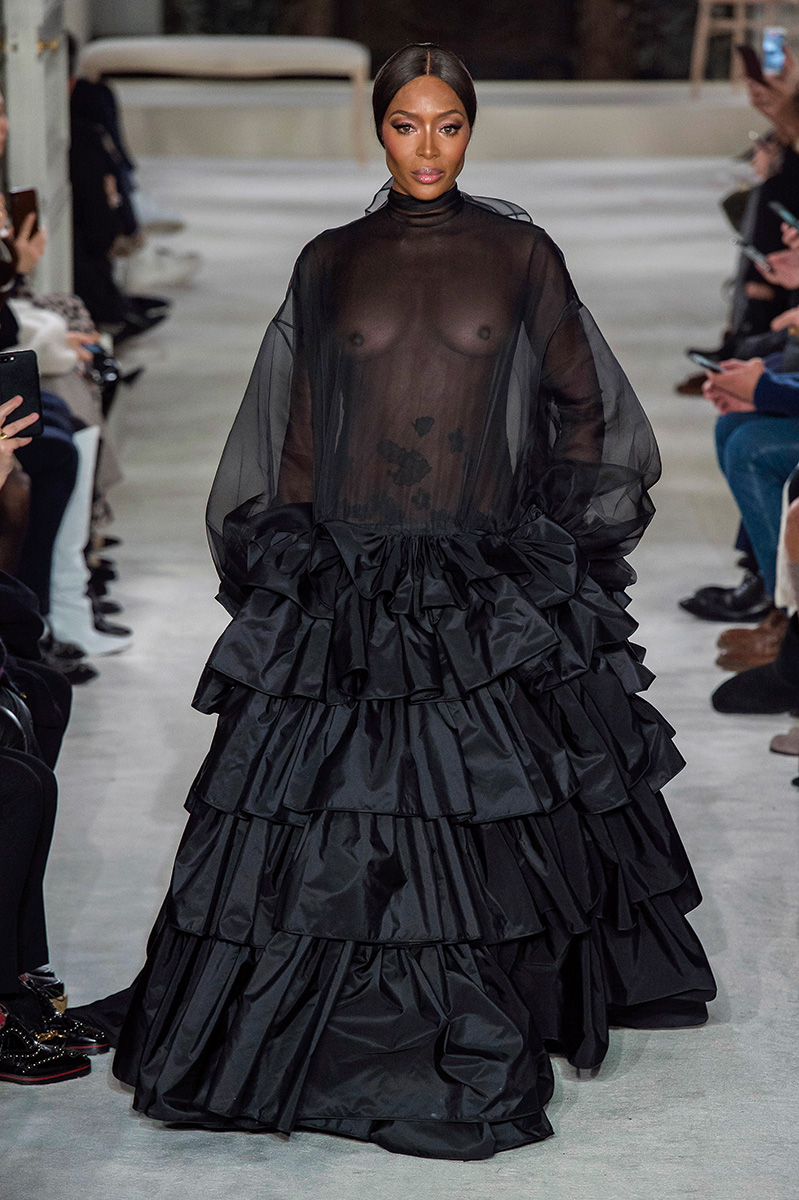
Naomi Campbell at the Valentino Haute Couture Spring/Summer 2019 show ©ImaxTree
Naomi Campbell at the Valentino Haute Couture Spring/Summer 2019 show ©ImaxTree
Adut Akech was the first model on the runway, in a sumptuous, breathtaking pink gown. There was romance, femininity and magic. There was an incredibly diverse cast. Céline Dion shed a tear and declared that beauty had been returned to women. Naomi Campbell did the honors and closes the show in an emotional moment, returning to the Valentino catwalk 14 years later. Everything seemed too good to be true, but the Haute Couture Spring/Summer 2019 show of the House, imagined by the creative genius of Pierpaolo Piccioli, was palpable and oh so real. “Was there anything more fantastic and yet, simultaneously, more real than the clothes Pierpaolo Piccioli showed for Valentino?”, Alexander Fury questioned in an AnOther piece about the collection. “Valentino couture often leaves you breathless, hysterical, giddy. (…) Valentino is a couture bender – you get drunk on the beauty. Most importantly, it makes you dream.”
Heart on my sleeve
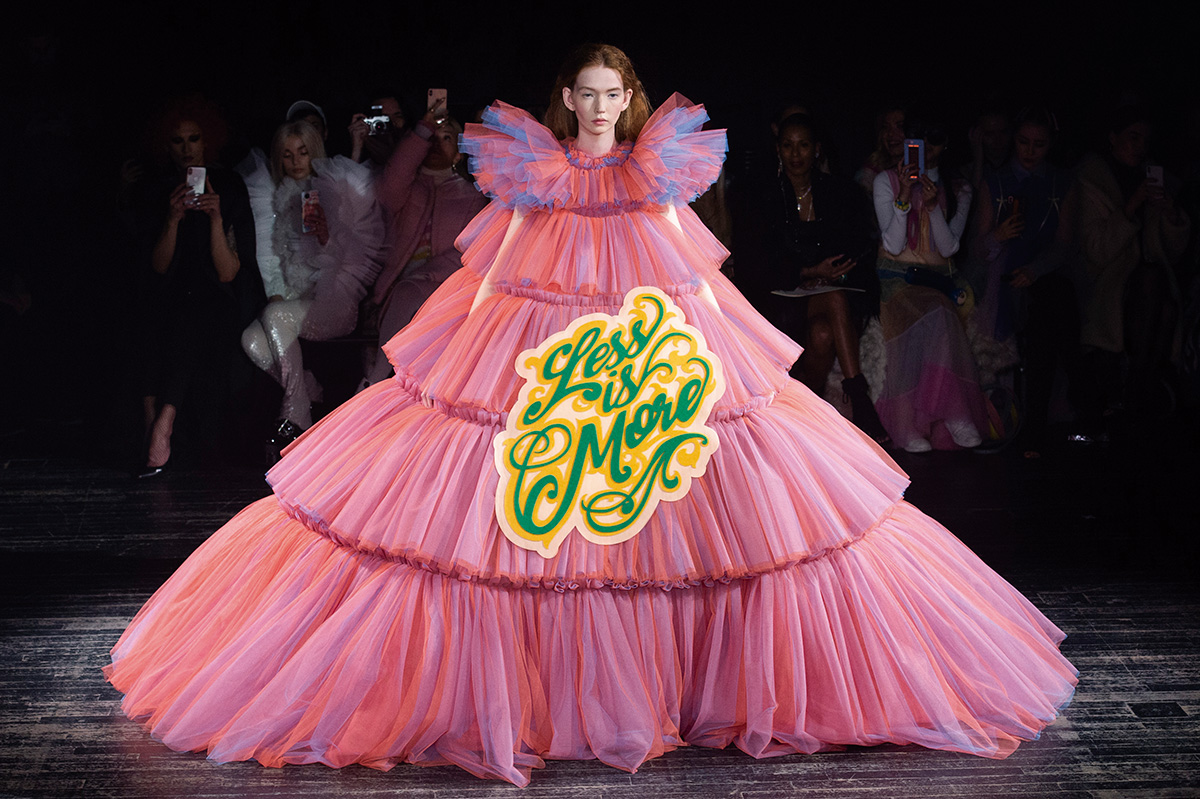
Viktor & Rolf Haute Couture Spring/Summer 2019 ©ImaxTree
Viktor & Rolf Haute Couture Spring/Summer 2019 ©ImaxTree
Who has never dreamed of saying everything they feel without having to use a single word? Exactly, all of us, every day. And who has never dreamed about saying everything they feel in a colorful Viktor & Rolf tulle dress, with an astonishing volume and the ironic “Sorry I’m late I didn’t want to come”, the hopeful “I want a better world” or the very direct “NO” replacing the need to move our lips? Exactly, all of us, ever since the creative duo Viktor Horsting and Rolf Snoeren presented their Haute Couture Spring/Summer 2019 collection, a sort of proof that dreams are not only open to interpretation, but also as imaginative as they are real. “It’s the kind of message you find on social media, with the same instant feeling,” Rolf Snoeren noted during a preview of the collection with WWD. “All these statements that are so obvious or easy — there’s a lot of banality on Instagram and social media in general — are counterbalanced with this over-the-top, shimmery, romantic feeling.”
Optical illusion
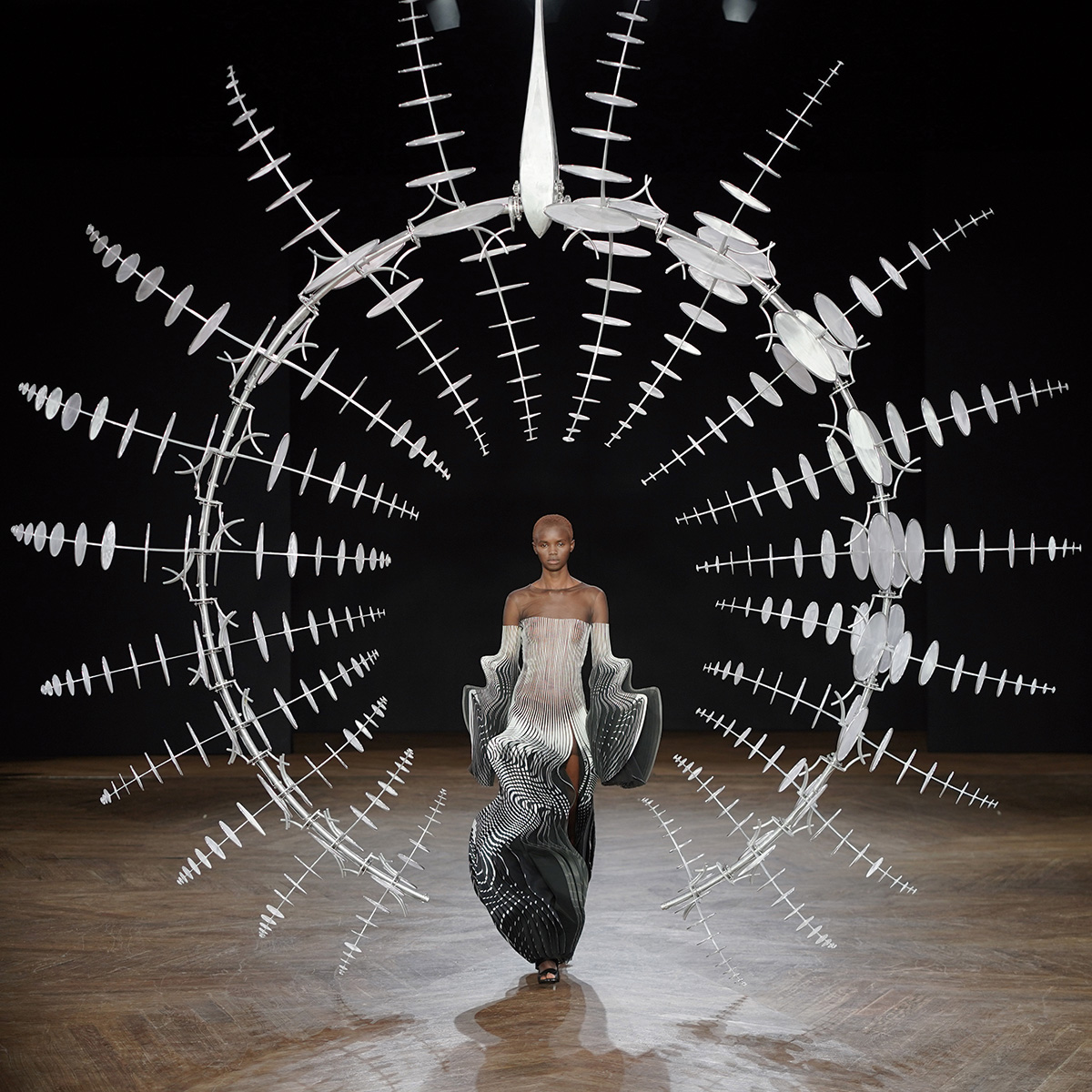
Iris van Herpen Haute Couture Fall/Winter 2019 ©Getty Images
Iris van Herpen Haute Couture Fall/Winter 2019 ©Getty Images
“Writing about Iris van Herpen, one can find oneself mired in the technicalities of her creations,” said Nicole Phelps, Vogue Runway’s director, in a review about the Dutch designer’s Haute Couture Fall/Winter 2019 collection. “There’s computer programming and physics and alchemy behind each one; they’re complicated to make and just as difficult to explain. Better is to think of her work as art pieces, with each dress a canvas and the model who wears it the frame on which it’s stretched.” Truly captivating to the sight, the sculptural looks created by Iris van Herpen are a proof of Fashion’s hypnotic power, in a mixture between nature’s beauty, technologies’ promise (3D printing is one of her signatures) and the use of unconventional materials. “In my world, I don’t see a distinction between nature and technology. They influence each other and they are obviously intertwined in our lives, even in our bodies nowadays. I think they are pure expressions of the dichotomy of our lives,” said Iris van Herpen in an interview with Vogue Arabia. “The pieces I make live in-between the worlds of art and fashion; I am very flexible about how people perceive them, as both are the truth.” And as Jessica Michault wrote in that same piece, “if haute couture is a factory of dreams, Iris van Herpen is one of its master weavers”.
Dream a little dream of me
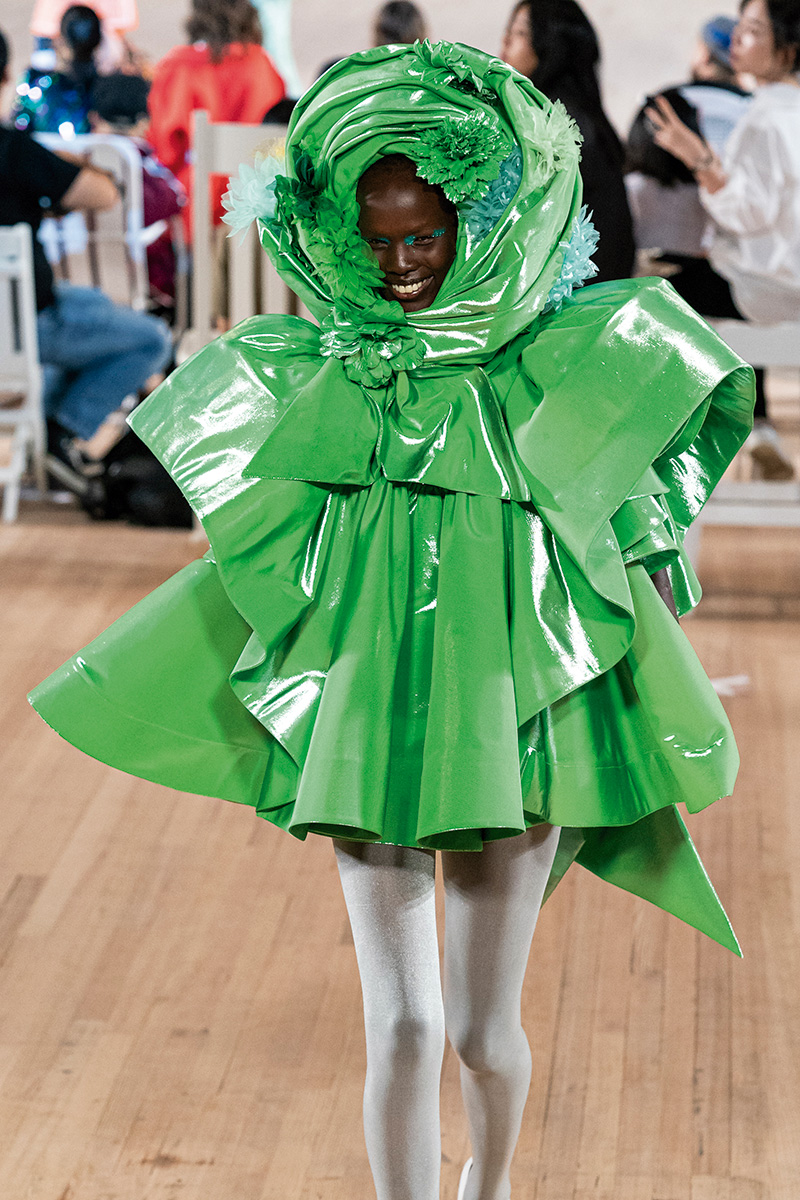
Marc Jacobs Spring/Summer 2020 ©ImaxTree
Marc Jacobs Spring/Summer 2020 ©ImaxTree
The song chosen by Marc Jacobs for his Spring/Summer 2020 show couldn’t have been more spot on. “While I’m alone and blue as can be,” the line of bright colors, floral prints and details full of personality that emerged in the beginning of the presentation erased any trace of sadness that could exist. Even at a distant, one could feel the energy. Models were smiling. Some of them blinked, others gave a little nod with their hats. There was joy and enthusiasm in the air. It was Fashion’s dream in its purest state. “Jacobs was aware that people leave his shows ‘feeling something’”, wrote Aatish Taseer in a New York Times piece titled “The Many Lives of Marc Jacobs”. “A mood, a spirit: the menacing shadow a bolero hat can cast on a spot-lit model’s face; the commanding, heart-stopping regality of a hyper-ruffled, puffed-up blood-red taffeta sleeve; the romantic loneliness of a single feather bobbing atop a knitted cap accompanying a gown made entirely of ocean-gray plumes.” The designer’s answer? “I don’t know how it happens. I can’t weave joy into a cloth. I can’t drape joy into a jacket. But I think there’s something within the process where the energy continues to grow and is somehow amplified and transferred within those seven minutes.” And that energy, as the Spring/Summer 2020 collection proved, is truly contagious.
Highest in the room
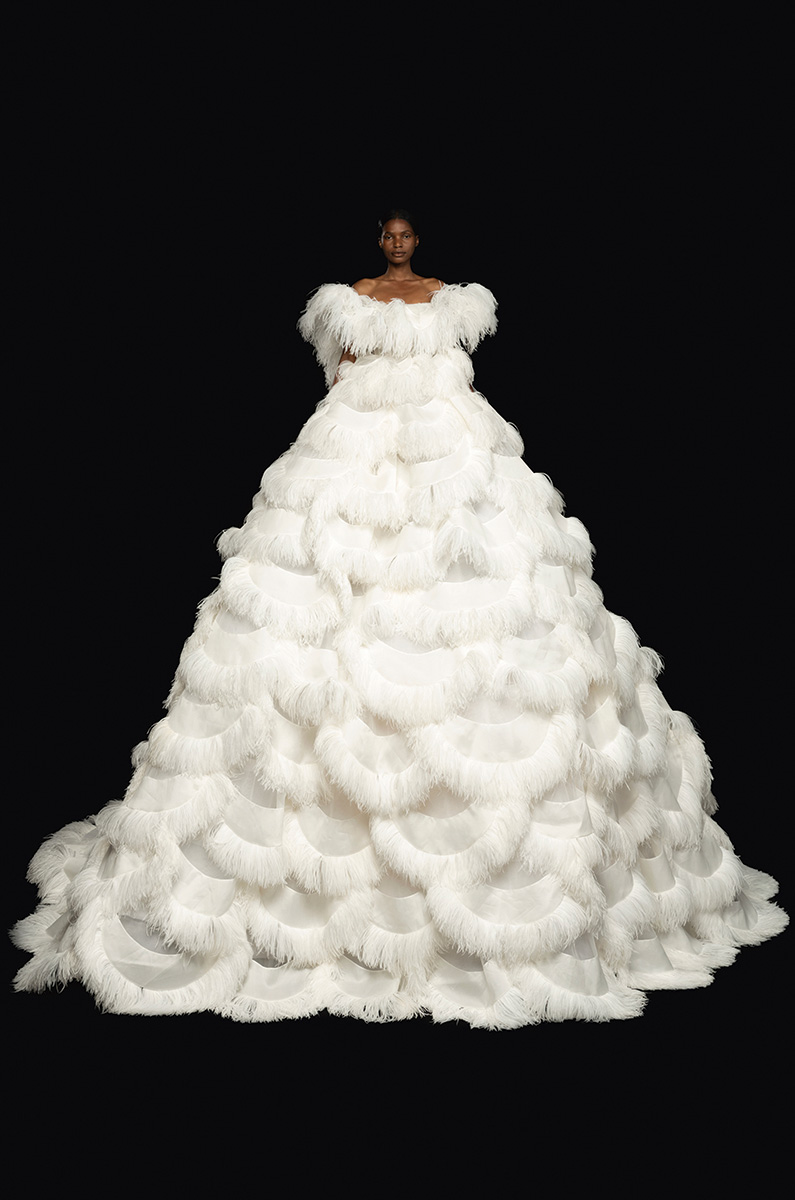
Valentino Haute Couture Fall 2020 ©ImaxTree
Valentino Haute Couture Fall 2020 ©ImaxTree
How many things do you need to make a dream come true? We say 16. More precisely, 16 dresses from “Of Grace and Light”, the Valentino Haute Couture Fall/Winter 2020 collection. In a moment where Fashion is still battling the devastating consequences of a global pandemic, questioning its role in the future and trying to find solutions to communicate the emotions that sometimes get lost when there is a screen dividing us, Pierpaolo Piccioli said “let there be light and grace”. The result was nothing short of a fantasy unrolling in front of our very own eyes: with Nick Knight and FKA Twigs by his side, Piccioli imagined a world with models suspended in the air, creating the illusion of six feet tall figures, and look where the extreme is taken to the extreme with impaired volumes, frills, feathers and fringes, “painted” in a pallet of silvers and whites. “White like a piece of paper waiting to be filled with lines and ideas. White like a labyrinth, a symbol of dedication, the first step in the building process,” the show notes said. And if it’s true that we need to rebuild, it’s also true that we need hope – and a sense of dreaming – to get there.“I didn’t want to feel the limitations. Couture is made for emotions, dreams,” said Piccioli. “It was super-emotional for us all to be here together to win this challenge. A moment I will never forget.”
Translated from Vogue Portugal's Hope issue, out September 2020. All credits in the original articles.Texto em português na edição em print.
Most popular
.png)
.png)

Relacionados



.jpg)

